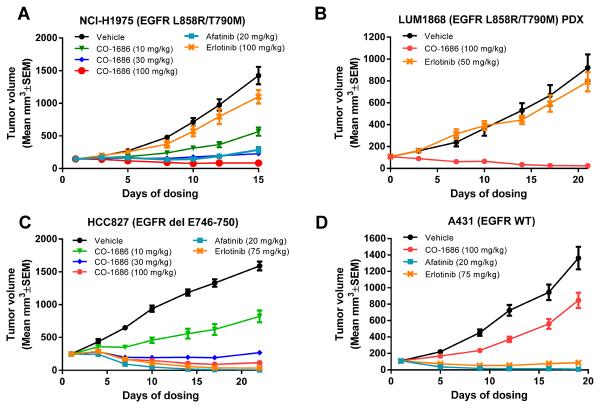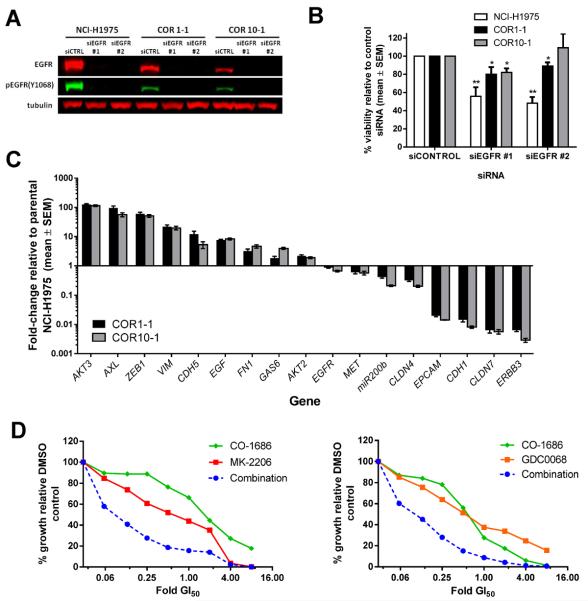
| Size | Price | Stock | Qty |
|---|---|---|---|
| 10mg |
|
||
| 25mg |
|
||
| 50mg |
|
||
| 100mg |
|
||
| 250mg |
|
||
| 500mg |
|
||
| 1g |
|
||
| Other Sizes |
|
Purity: ≥98%
Rociletinib (formerly CO1686; AVL301; CNX419) is an orally bioavailable, covalent / irreversible, and mutant-selective EGFR (e.g. T790M) inhibitor with potential antineoplastic activity. In cell-free experiments, it inhibits EGFRWT and EGFRL858R/T790M with Ki values of 21.5 nM and 303.3 nM, respectively. By binding to and inhibiting mutant forms of EGFR, such as T790M, rociletinib exhibits strong anti-proliferative activity in vitro and high in vivo antitumor efficacy, ultimately resulting in the death of resistant tumor cells.
| Targets |
EGFRL858R/T790M (Ki = 21.5 nM); EGFRT790M (Ki = 303.3 nM)
|
|
|---|---|---|
| ln Vitro |
|
|
| ln Vivo |
|
|
| Enzyme Assay |
In the assay, Nterminal GST-tagged recombinant human wild-type and T790M/L858R double mutant EGFR are utilized. The vendor's instructions are followed when performing the Omnia continuous read assay.
|
|
| Cell Assay |
In growth media supplemented with 5% FBS, 2 mmol/L, L-glutamine, and 1% penicillin–streptomycin, cells are seeded at 3,000 cells per well. After an overnight adhesion period, the cells are treated for 72 hours with a dilution series of test compounds. CellTiter-Glo is used to measure cell viability; the results are shown as background-subtracted relative light units normalized to a control that was treated with dimethyl sulfoxide (DMSO). MK-2206 and XL-880 compounds are acquired from Selleck Chemical. GraphPad Prism 5.04 is used to calculate growth inhibition (GI 50) values. CalcuSyn is used to generate the CI data.
|
|
| Animal Protocol |
In summary, 1×107 tumor cells in 50% Matrigel are subcutaneously injected into NCr nu/nu mice at a volume of 0.2 mL/mouse. Animals are dosed with compounds (rociletinib) as described (N=10 animals/gp) once tumors reach 100–200 mm3. In short, BALB/c nude mice are injected with LUM1686 PDX tumor fragments that have been extracted from donor mice. Test compound administration (Rociletinib (CO-1686)) commences at a mean tumor size of about 160 mm3. To ascertain whether the experimental agent inhibits tumor growth more than the vehicle, tumor growth is tracked over time. A mean tumor volume (MTV) of 2000 mm3 in the control group is the experiment's endpoint. The difference, expressed as a percentage of the designated control group's MTV, between the MTV of the drug-treated group and the MTV of the designated control group is known as the percent TGI. SEM, or standard error of the mean, is the data's presentation format.
|
|
| References | ||
| Additional Infomation |
Rociletinib has been used in trials studying the treatment and prevention of Nonsmall Cell Lung Cancer, Non-small Cell Lung Cancer, and Locally Advanced or Metastatic Non-small Cell Lung Cancer.
Rociletinib is an orally available small molecule, irreversible inhibitor of epidermal growth factor receptor (EGFR) with potential antineoplastic activity. Rociletinib binds to and inhibits mutant forms of EGFR, including T790M, thereby leading to cell death of resistant tumor cells. Compared to other EGFR inhibitors, CO-1686 inhibits T790M, a secondary acquired resistance mutation, as well as other mutant EGFRs and may have therapeutic benefits in tumors with T790M-mediated resistance to other EGFR tyrosine kinase inhibitors. This agent shows minimal activity against wild-type EGFR, hence does not cause certain dose-limiting toxicities. |
| Molecular Formula |
C27H28F3N7O3
|
|---|---|
| Molecular Weight |
555.55
|
| Exact Mass |
555.22
|
| Elemental Analysis |
C, 58.37; H, 5.08; F, 10.26; N, 17.65; O, 8.64
|
| CAS # |
1374640-70-6
|
| Related CAS # |
Rociletinib hydrobromide;1446700-26-0
|
| PubChem CID |
57335384
|
| Appearance |
white to off-white solid powder
|
| Density |
1.4±0.1 g/cm3
|
| Index of Refraction |
1.632
|
| LogP |
2.38
|
| Hydrogen Bond Donor Count |
3
|
| Hydrogen Bond Acceptor Count |
11
|
| Rotatable Bond Count |
8
|
| Heavy Atom Count |
40
|
| Complexity |
871
|
| Defined Atom Stereocenter Count |
0
|
| SMILES |
FC(C1=C([H])N=C(N=C1N([H])C1C([H])=C([H])C([H])=C(C=1[H])N([H])C(C([H])=C([H])[H])=O)N([H])C1C([H])=C([H])C(=C([H])C=1OC([H])([H])[H])N1C([H])([H])C([H])([H])N(C(C([H])([H])[H])=O)C([H])([H])C1([H])[H])(F)F
|
| InChi Key |
HUFOZJXAKZVRNJ-UHFFFAOYSA-N
|
| InChi Code |
InChI=1S/C27H28F3N7O3/c1-4-24(39)32-18-6-5-7-19(14-18)33-25-21(27(28,29)30)16-31-26(35-25)34-22-9-8-20(15-23(22)40-3)37-12-10-36(11-13-37)17(2)38/h4-9,14-16H,1,10-13H2,2-3H3,(H,32,39)(H2,31,33,34,35)
|
| Chemical Name |
N-[3-[[2-[4-(4-acetylpiperazin-1-yl)-2-methoxyanilino]-5-(trifluoromethyl)pyrimidin-4-yl]amino]phenyl]prop-2-enamide
|
| Synonyms |
Rociletinib; AVL301; CO 1686; AVL 301; CNX419; AVL-301; CO1686; CO-1686; CNX 419; CNX-419
|
| HS Tariff Code |
2934.99.9001
|
| Storage |
Powder -20°C 3 years 4°C 2 years In solvent -80°C 6 months -20°C 1 month |
| Shipping Condition |
Room temperature (This product is stable at ambient temperature for a few days during ordinary shipping and time spent in Customs)
|
| Solubility (In Vitro) |
|
|||
|---|---|---|---|---|
| Solubility (In Vivo) |
Solubility in Formulation 1: ≥ 2.5 mg/mL (4.50 mM) (saturation unknown) in 10% DMSO + 40% PEG300 + 5% Tween80 + 45% Saline (add these co-solvents sequentially from left to right, and one by one), clear solution.
For example, if 1 mL of working solution is to be prepared, you can add 100 μL of 25.0 mg/mL clear DMSO stock solution to 400 μL PEG300 and mix evenly; then add 50 μL Tween-80 to the above solution and mix evenly; then add 450 μL normal saline to adjust the volume to 1 mL. Preparation of saline: Dissolve 0.9 g of sodium chloride in 100 mL ddH₂ O to obtain a clear solution. Solubility in Formulation 2: ≥ 2.5 mg/mL (4.50 mM) (saturation unknown) in 10% DMSO + 90% Corn Oil (add these co-solvents sequentially from left to right, and one by one), clear solution. For example, if 1 mL of working solution is to be prepared, you can add 100 μL of 25.0 mg/mL clear DMSO stock solution to 900 μL of corn oil and mix evenly. View More
Solubility in Formulation 3: 1% DMSO+30% polyethylene glycol+1% Tween 80: 30 mg/mL |
| Preparing Stock Solutions | 1 mg | 5 mg | 10 mg | |
| 1 mM | 1.8000 mL | 9.0001 mL | 18.0002 mL | |
| 5 mM | 0.3600 mL | 1.8000 mL | 3.6000 mL | |
| 10 mM | 0.1800 mL | 0.9000 mL | 1.8000 mL |
*Note: Please select an appropriate solvent for the preparation of stock solution based on your experiment needs. For most products, DMSO can be used for preparing stock solutions (e.g. 5 mM, 10 mM, or 20 mM concentration); some products with high aqueous solubility may be dissolved in water directly. Solubility information is available at the above Solubility Data section. Once the stock solution is prepared, aliquot it to routine usage volumes and store at -20°C or -80°C. Avoid repeated freeze and thaw cycles.
Calculation results
Working concentration: mg/mL;
Method for preparing DMSO stock solution: mg drug pre-dissolved in μL DMSO (stock solution concentration mg/mL). Please contact us first if the concentration exceeds the DMSO solubility of the batch of drug.
Method for preparing in vivo formulation::Take μL DMSO stock solution, next add μL PEG300, mix and clarify, next addμL Tween 80, mix and clarify, next add μL ddH2O,mix and clarify.
(1) Please be sure that the solution is clear before the addition of next solvent. Dissolution methods like vortex, ultrasound or warming and heat may be used to aid dissolving.
(2) Be sure to add the solvent(s) in order.
| NCT Number | Recruitment | interventions | Conditions | Sponsor/Collaborators | Start Date | Phases |
| NCT02147990 | Terminated | Drug: Rociletinib | Non-small Cell Lung Cancer | Clovis Oncology, Inc. | June 16, 2014 | Phase 2 |
| NCT02630186 | Terminated | Drug: Rociletinib Drug: MPDL3280A |
Non-small Cell Lung Cancer | Clovis Oncology, Inc. | February 24, 2016 | Phase 1 Phase 2 |
| NCT02580708 | Terminated | Drug: Rociletinib Drug: Trametinib |
Non-small Cell Lung Cancer | Clovis Oncology, Inc. | September 30, 2015 | Phase 1 Phase 2 |
|
 |
 |